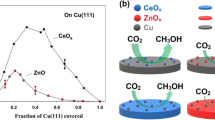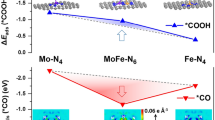Abstract
Co-based catalysts for CO2 reduction to liquid fuels have been attracting increasing attention. In this work, the distribution of surface intermediates on a polycrystalline Co foil was investigated by ambient-pressure X-ray photoelectron spectroscopy (APXPS) experiments under near ambient pressure and temperature conditions. The Co surface was partially oxidized, predominantly by carbonates, after CO2 dissociative adsorption. Graphitic carbon deposition on the partially oxidized Co surface was significantly lesser than that on the open surfaces of Cu and Ni under similar reaction conditions. Methoxy, formate, and a bulk carbonate formed upon the co-adsorption of H2O with a surprisingly high methoxy/formate coverage ratio. These results provide valuable mechanistic information for developing highly selective Co-based catalysts for CO2 reduction.
Graphical Abstract




Similar content being viewed by others
References
Centi G, Perathoner S (2009) Opportunities and prospects in the chemical recycling of carbon dioxide to fuels. Catal Today 148(3–4):191–205
Schlögl R (2015) Heterogeneous catalysis. Angew Chem Int Ed 54(11):3465–3520
Wang W, Wang S, Ma X et al (2011) Recent advances in catalytic hydrogenation of carbon dioxide. Chem Soc Rev 40(7):3703–3727
Hoekman SK, Broch A, Robbins C et al (2010) CO2 recycling by reaction with renewably-generated hydrogen. Int J Greenh Gas Control 4(1):44–50
Schrag DP (2007) Preparing to Capture Carbon. Science 315(5813):812–813
Wang W-H, Himeda Y, Muckerman JT et al (2015) CO2 hydrogenation to formate and methanol as an alternative to photo-and electrochemical CO2 reduction. Chem Rev 115(23):12936–12973
Gattrell M, Gupta N, Co A (2006) A review of the aqueous electrochemical reduction of CO2 to hydrocarbons at copper. J Electroanal Chem 594(1):1–19
Whipple DT, Kenis PJ (2010) Prospects of CO2 utilization via direct heterogeneous electrochemical reduction. J Phys Chem Lett 1(24):3451–3458
Zhao Y-F, Yang Y, Mims C et al (2011) Insight into methanol synthesis from CO2 hydrogenation on Cu(111): complex reaction network and the effects of H2O. J Catal 281(2):199–211
Nie X, Esopi MR, Janik MJ et al (2013) Selectivity of CO2 reduction on copper electrodes: the role of the kinetics of elementary steps. Angew Chem Int Ed 52(9):2459–2462
Weatherbee GD, Bartholomew CH (1984) Hydrogenation of CO2 on group VIII metals: IV. Specific activities and selectivities of silica-supported Co, Fe, and Ru. J Catal 87(2):352–362
Gao S, Lin Y, Jiao X et al (2016) Partially oxidized atomic cobalt layers for carbon dioxide electroreduction to liquid fuel. Nature 529(7584):68–71
Li C-S, Melaet G, Ralston WT et al (2015) High-performance hybrid oxide catalyst of manganese and cobalt for low-pressure methanol synthesis. Nat Commun 6:6538
Grass ME, Karlsson PG, Aksoy F et al (2010) New ambient pressure photoemission endstation at Advanced Light Source beamline 9.3.2. Rev Sci Instrum 81(5):053106
Jablonski A (2010) NIST Electron Inelastic-Mean-Free-Path Database. National Institute of Standards and Technology, Gaithersburg
Biesinger MC, Payne BP, Grosvenor AP et al (2011) Resolving surface chemical states in XPS analysis of first row transition metals, oxides and hydroxides: Cr, Mn, Fe, Co and Ni. Appl Surf Sci 257(7):2717–2730
Powell CJ (2012) Recommended Auger parameters for 42 elemental solids. J Electron Spectrosc Relat Phenom 185(1):1–3
Fei Tan K, Xu J, Chang J et al (2010) Carbon deposition on Co catalysts during Fischer–Tropsch synthesis: a computational and experimental study. J Catal 274(2):121–129
Weatherup RS, Amara H, Blume R et al (2014) Interdependency of subsurface carbon distribution and graphene–catalyst interaction. J Am Chem Soc 136(39):13698–13708
Heine C, Lechner BA, Bluhm H et al (2016) Recycling of CO2: probing the chemical state of the Ni(111) surface during the methanation reaction with ambient-pressure X-ray photoelectron spectroscopy. J Am Chem Soc 138(40):13246–13252
Deng X, Verdaguer A, Herranz T et al (2008) Surface chemistry of Cu in the presence of CO2 and H2O. Langmuir 24(17):9474–9478
Víctor A, González S, Illas F et al (2008) Evidence for spontaneous CO2 activation on cobalt surfaces. Chem Phys Lett 454(4):262–268
Ko J, Kim B-K, Han JW (2016) Density functional theory study for catalytic activation and dissociation of CO2 on bimetallic alloy surfaces. J Phys Chem C 120(6):3438–3447
Monachino E, Greiner M, Knop-Gericke A et al (2014) Reactivity of carbon dioxide on nickel: role of CO in the competing interplay between oxygen and graphene. J Phys Chem Lett 5(11):1929–1934
Wu CH, Eren B, Bluhm H et al (2017) Ambient-pressure X-ray photoelectron spectroscopy study of cobalt foil model catalyst under CO, H2, and their mixtures. ACS Catal 7(2):1150–1157
Wesner DA, Linden G, Bonzel HP (1986) Alkali promotion on cobalt: surface analysis of the effects of potassium on carbon monoxide adsorption and Fischer-Tropsch reaction. Appl Surf Sci 26(3):335–356
Lahtinen J, Vaari J, Kauraala K (1998) Adsorption and structure dependent desorption of CO on Co(0001). Surf Sci 418(3):502–510
Yaron D, Peterson K, Zolandz D et al (1990) Water hydrogen bonding: the structure of the water–carbon monoxide complex. J Chem Phys 92(12):7095–7109
Favaro M, Xiao H, Cheng T et al (2017) Subsurface oxide plays a critical role in CO2 activation by Cu(111) surfaces to form chemisorbed CO2, the first step in reduction of CO2. Proc Natl Acad Sci USA 114:6706–6711
Lin W, Stocker KM, Schatz GC (2017) Mechanisms of hydrogen-assisted CO2 reduction on nickel. J Am Chem Soc 139(13):4663–4666
Peng G, Sibener S, Schatz GC et al (2012) CO2 hydrogenation to formic acid on Ni(111). J Phys Chem C 116(4):3001–3006
Cheng T, Xiao H, Goddard WA III (2016) Reaction mechanisms for the electrochemical reduction of CO2 to CO and formate on the Cu(100) surface at 298 K from quantum mechanics free energy calculations with explicit water. J Am Chem Soc 138(42):13802–13805
Grabow LC, Mavrikakis M (2011) Mechanism of methanol synthesis on Cu through CO2 and CO hydrogenation. ACS Catal 1(4):365–384
Bartholomew CH, Farrauto RJ (2011) Fundamentals of industrial catalytic processes. Wiley, New York
Han Y, Axnanda S, Crumlin EJ et al (2017) Observing the electrochemical oxidation of Co metal at the solid/liquid interface using ambient pressure X-ray photoelectron spectroscopy. J Phys Chem B 122(2):666–671
Acknowledgements
The part of this work performed in China was supported by the National Natural Science Foundation of China (11227902) and the Science and Technology Commission of Shanghai Municipality (14520722100). Y.L. would like to acknowledge the support of the “Hundred Talents Program” of the Chinese Academy of Sciences. The work performed at the Advanced Light Source is supported by the Director, Office of Science, Office of Basic Energy Sciences of the U.S. Department of Energy under Contract No. DE-AC02- 05CH11231.
Author information
Authors and Affiliations
Corresponding authors
Ethics declarations
Conflict of interest
The authors declares that they have no competing interest.
Rights and permissions
About this article
Cite this article
Liu, Q., Han, Y., Cai, J. et al. CO2 Activation on Cobalt Surface in the Presence of H2O: An Ambient-Pressure X-ray Photoelectron Spectroscopy Study. Catal Lett 148, 1686–1691 (2018). https://doi.org/10.1007/s10562-018-2362-z
Received:
Accepted:
Published:
Issue Date:
DOI: https://doi.org/10.1007/s10562-018-2362-z




